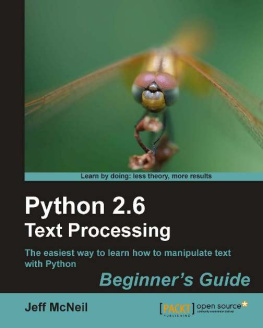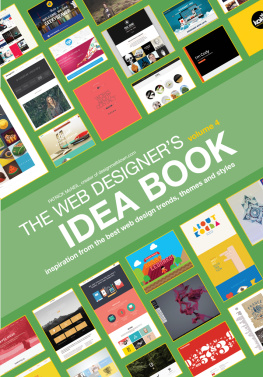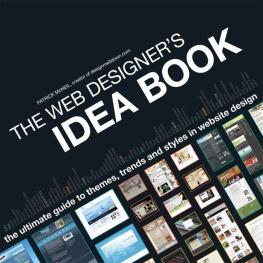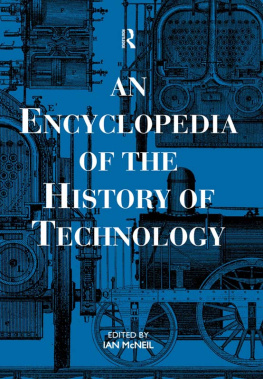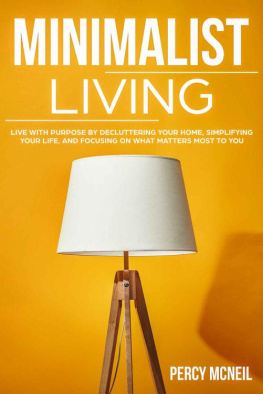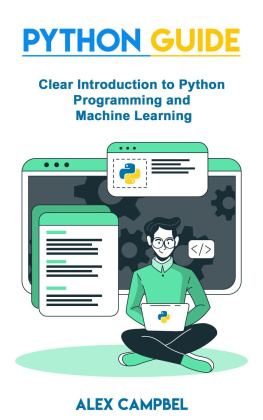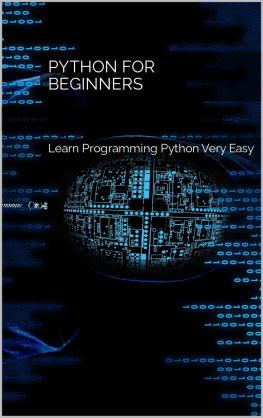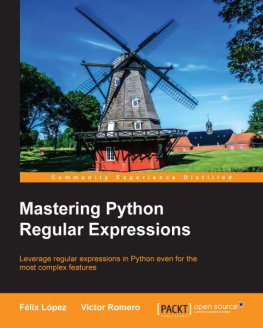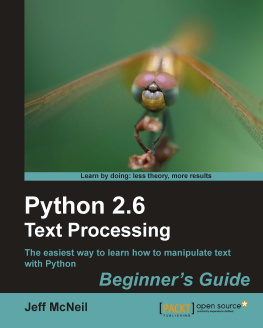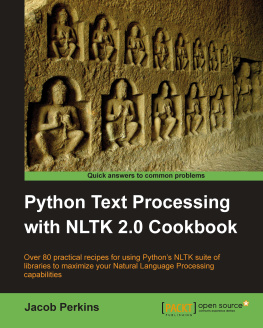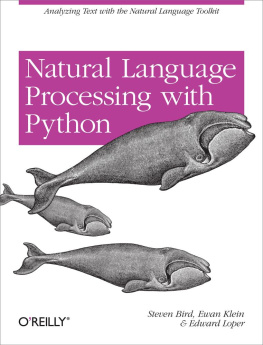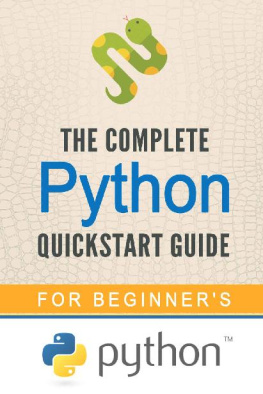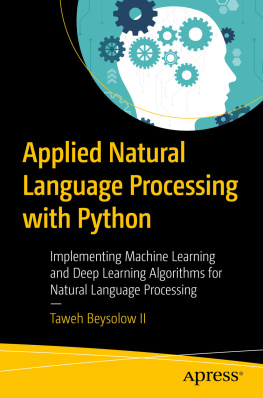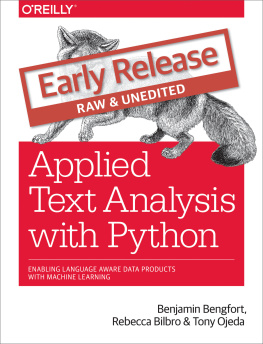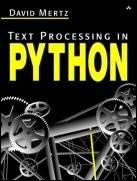McNeil - Python 2.6 text processing: beginners guide: the easiest way to learn how to manipulate text with Python
Here you can read online McNeil - Python 2.6 text processing: beginners guide: the easiest way to learn how to manipulate text with Python full text of the book (entire story) in english for free. Download pdf and epub, get meaning, cover and reviews about this ebook. City: Birmingham, UK, year: 2010, publisher: Packt Pub. Open Source, genre: Computer. Description of the work, (preface) as well as reviews are available. Best literature library LitArk.com created for fans of good reading and offers a wide selection of genres:
Romance novel
Science fiction
Adventure
Detective
Science
History
Home and family
Prose
Art
Politics
Computer
Non-fiction
Religion
Business
Children
Humor
Choose a favorite category and find really read worthwhile books. Enjoy immersion in the world of imagination, feel the emotions of the characters or learn something new for yourself, make an fascinating discovery.
Python 2.6 text processing: beginners guide: the easiest way to learn how to manipulate text with Python: summary, description and annotation
We offer to read an annotation, description, summary or preface (depends on what the author of the book "Python 2.6 text processing: beginners guide: the easiest way to learn how to manipulate text with Python" wrote himself). If you haven't found the necessary information about the book — write in the comments, we will try to find it.
Python 2.6 text processing: beginners guide: the easiest way to learn how to manipulate text with Python — read online for free the complete book (whole text) full work
Below is the text of the book, divided by pages. System saving the place of the last page read, allows you to conveniently read the book "Python 2.6 text processing: beginners guide: the easiest way to learn how to manipulate text with Python" online for free, without having to search again every time where you left off. Put a bookmark, and you can go to the page where you finished reading at any time.
Font size:
Interval:
Bookmark:
Beginner's Guide
Copyright 2010 Packt Publishing
All rights reserved. No part of this book may be reproduced, stored in a retrieval system, or transmitted in any form or by any means, without the prior written permission of the publisher, except in the case of brief quotations embedded in critical articles or reviews.
Every effort has been made in the preparation of this book to ensure the accuracy of the information presented. However, the information contained in this book is sold without warranty, either express or implied. Neither the author, nor Packt Publishing, and its dealers and distributors will be held liable for any damages caused or alleged to be caused directly or indirectly by this book.
Packt Publishing has endeavored to provide trademark information about all of the companies and products mentioned in this book by the appropriate use of capitals. However, Packt Publishing cannot guarantee the accuracy of this information.
First published: December 2010
Production Reference: 1081210
Published by Packt Publishing Ltd. 32 Lincoln Road Olton Birmingham, B27 6PA, UK.
ISBN 978-1-849512-12-1
www.packtpub.com
Cover Image by John Quick ( <> )
Author
Jeff McNeil
Reviewer
Maurice HT Ling
Acquisition Editor
Steven Wilding
Development Editor
Reshma Sundaresan
Technical Editor
Gauri Iyer
Indexer
Tejal Daruwale
Editorial Team Leader
Mithun Sehgal
Project Team Leader
Priya Mukherji
Project Coordinator
Shubhanjan Chatterjee
Proofreader
Jonathan Todd
Graphics
Nilesh R. Mohite
Production Coordinator
Kruthika Bangera
Cover Work
Kruthika Bangera
Jeff McNeil has been working in the Internet Services industry for over 10 years. He cut his teeth during the late 90's Internet boom and has been developing software for Unix and Unix-flavored systems ever since. Jeff has been a full-time Python developer for the better half of that time and has professional experience with a collection of other languages, including C, Java, and Perl. He takes an interest in systems administration and server automation problems. Jeff recently joined Google and has had the pleasure of working with some very talented individuals.
I'd like to above all thank Julie, Savannah, Phoebe, Maya, and Trixie for allowing me to lock myself in the office every night for months. The Web.com gang and those in the Python community willing to share their authoring experiences. Finally, Steven Wilding, Reshma Sundaresan, Shubhanjan Chatterjee, and the rest of the Packt Publishing team for all of the hard work and guidance.
Maurice HT Ling completed his Ph.D. in Bioinformatics and B.Sc(Hons) in Molecular and Cell Biology from the University of Melbourne where he worked on microarray analysis and text mining for protein-protein interactions. He is currently an honorary fellow in the University of Melbourne, Australia. Maurice holds several Chief Editorships, including the Python papers, Computational, and Mathematical Biology, and Methods and Cases in Computational, Mathematical and Statistical Biology. In Singapore, he co-founded the Python User Group (Singapore) and is the co-chair of PyCon Asia-Pacific 2010. In his free time, Maurice likes to train in the gym, read, and enjoy a good cup of coffee. He is also a senior fellow of the International Fitness Association, USA.
You might want to visit www.PacktPub.com for support files and downloads related to your book.
Did you know that Packt offers eBook versions of every book published, with PDF and ePub files available? You can upgrade to the eBook version at > for more details.
At www.PacktPub.com, you can also read a collection of free technical articles, sign up for a range of free newsletters, and receive exclusive discounts and offers on Packt books and eBooks.

http://PacktLib.PacktPub.com
Do you need instant solutions to your IT questions? PacktLib is Packt's online digital book library. Here, you can access, read, and search across Packt's entire library of books.
- Fully searchable across every book published by Packt
- Copy and paste, print, and bookmark content
- On demand and accessible via web browser
If you have an account with Packt at www.PacktPub.com, you can use this to access PacktLib today and view nine entirely free books. Simply use your login credentials for immediate access.
The Python Text Processing Beginner's Guide is intended to provide a gentle, hands-on introduction to processing, understanding, and generating textual data using the Python programming language. Care is taken to ensure the content is example-driven, while still providing enough background information to allow for a solid understanding of the topics covered.
Throughout the book, we use real world examples such as logfile processing and PDF creation to help you further understand different aspects of text handling. By the time you've finished, you'll have a solid working knowledge of both structured and unstructured text data management. We'll also look at practical indexing and character encodings.
A good deal of supporting information is included. We'll touch on packaging, Python IO, third-party utilities, and some details on working with the Python 3 series releases. We'll even spend a bit of time porting a small example application to the latest version.
Finally, we do our best to provide a number of high quality external references. While this book will cover a broad range of topics, we also want to help you dig deeper when necessary.
, Getting Started: This chapter provides an introduction into character and string data types and how strings are represented using underlying integers. We'll implement a simple encoding script to illustrate how text can be manipulated at the character level. We also set up our systems to allow safe third-party library installation.
, Working with the IO System: Here, you'll learn how to access your data. We cover Python's IO capabilities in this chapter. We'll learn how to access files locally and remotely. Finally, we cover how Python's IO layers change in Python 3.
, Python String Services: Covers Python's core string functionality. We look at the methods of string objects, the core template classes, and Python's various string formatting methods. We introduce the differences between Unicode and string objects here.
, Test Processing Using the Standard Library: The standard Python distribution includes a powerful set of built-in libraries designed to manage textual content. We look at configuration file reading and manipulation, CSV files, and JSON data. We take a bit of a detour at the end of this chapter to learn how to create your own redistributable Python egg files.
Font size:
Interval:
Bookmark:
Similar books «Python 2.6 text processing: beginners guide: the easiest way to learn how to manipulate text with Python»
Look at similar books to Python 2.6 text processing: beginners guide: the easiest way to learn how to manipulate text with Python. We have selected literature similar in name and meaning in the hope of providing readers with more options to find new, interesting, not yet read works.
Discussion, reviews of the book Python 2.6 text processing: beginners guide: the easiest way to learn how to manipulate text with Python and just readers' own opinions. Leave your comments, write what you think about the work, its meaning or the main characters. Specify what exactly you liked and what you didn't like, and why you think so.

